A speed cord is a versatile tool for applying resistance to traditional strength and plyometric exercises. These bands increase intensity and improve core engagement during movement. It is most common to use the bands for agility and plyometric training, but they can also be used to increase resistance and challenge to functional resistance exercises.
Various fitness companies offer a broad range of speed cord equipment, but the most common ones includes a waist belt and a bungee cord. Other attachments include thigh, chest and arm belts. Resistance ranges from light to heavy and length varies between 6 and 10 feet.
For safety, do not apply full tension or stretch the bungee to its maximum. This creates too much resistance and wears out the belt and buckle. Use the following speed cord drills as a means to intensify a workout and progress clients to the next level of challenge.
Knee Tucks on a Ballast Ball
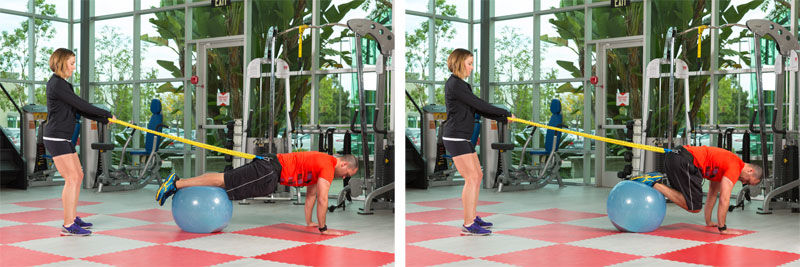
This exercise forces the core to engage while maintaining balance on a ballast ball. Trainers can apply resistance from behind or the sides of the body. This alters the contraction to focus on a unilateral or bilateral contraction.
How to Perform
Have the client assume a plank position with the knees on top of the ballast ball and hands on the ground. Stand behind the client and apply some resistance on the cord. Instruct the client to lift the hips while tucking the knees forward. The ball will roll toward the shoelaces. Return back to the plank position and repeat. Complete two to three sets of 10 to 12 reps.
*You can use a stability ball, but it is less stable and causes more concern for safety.
Bear Crawls to Plank With Touches
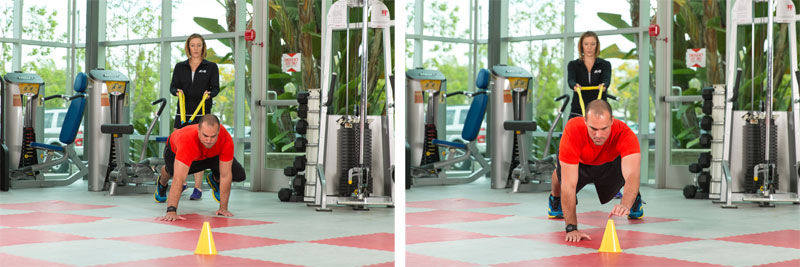
This exercise engages the entire body in a powerful movement to improve speed, power and endurance. Quicker bear crawls are also called full-body sprints, and involve running on all fours. The resistance is applied on the forward motion, which also trains control on the deceleration or backward motion.
How to Perform
Place a cone 10 to 12 feet in front of the client. Stand behind the client and apply resistance. When the client is near the cone, he or she should feel the greatest resistance. Cue the client to crawl forward toward the cone and tap the cone with one hand, and crawl back to the starting position. Repeat five times. On the fifth rep, cue the client to stay near the cone in a plank position and tap the cone five times with each hand. Return to center and rest for 20 to 30 seconds. Repeat two to three times.
*The slower bear crawl focuses more on strength, while the faster crawl focuses more on power and high-intensity training.
Triangle Reaction Drill

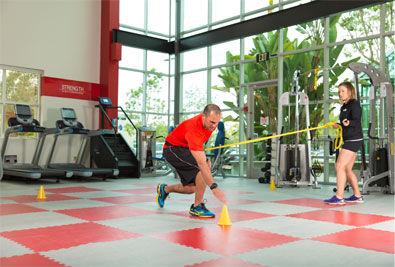
This exercise trains reaction, because the client must respond to the direction of movement initiated by the trainer. The loaded movement occurs during backpedalling, so the client can explode in the forward sprint motion with assistance.
How to Perform
Place three cones in a triangle, 15 feet apart from each other. Stand at the base, directly between the two “base” cones. (The apex cone should be aligned with the client.) Clip the cord in the front of the client’s body. Cue the client to pedal backward toward the apex cone. Once the client reaches the cone, initiate a movement of going to the left or right cone. The client must react and sprint toward that cone. For example, if you move to the right cone, then the client should run to the right cone. The client should begin to decelerate the forward sprint once he or she reaches the cone. Repeat five times and break. Complete two to three sets.
*The client should not stop during the backpedalling portion, but keep pedaling backwards until he or she reacts to your movement.
W Cone Drill

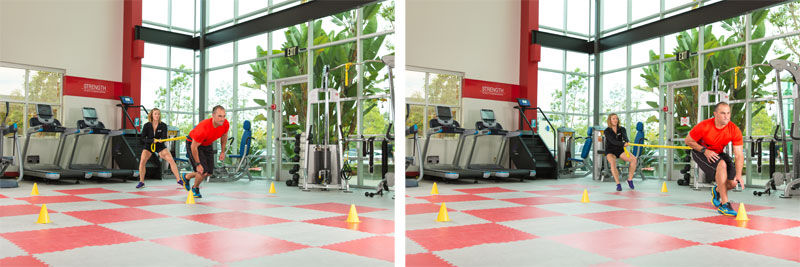
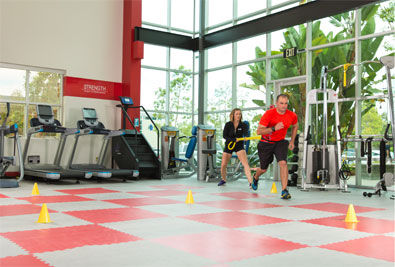
The band can be anchored either in the front of back of the belt for this drill. Practicing both positions places the resistance on the forward sprinting and backward pedaling motion. The band will apply resistance and assistance during the entire drill.
How to Perform
Set up five cones in a “W” configuration, with the cones 15 feet apart. Anchor the belt on the front or back of the client. (It is ideal to practice both). Start at one end of the “W” and cue the client to begin moving toward each cone while you maintain resistance on the cord. Once the client reaches the last cone, cue them to sprint forward about 20 feet to you. Rest and repeat up to five repetitions.
BOSU Bungee Jumps

The bungee can be anchored behind or on the sides of the body during this drill. This applies resistance on the “work” phase, where more power is required to explode on top of the BOSU.
How to Perform
Position the client 2 to 3 feet behind the BOSU. Stand behind the client to apply resistance. Cue the client to squat, load and explode on top of the dome. Have the client stick on top of the dome for three seconds and jump back to center. Complete one set of 10 reps behind the dome and move to the side of the dome to perform lateral jumps. Stand to the left side of the dome, with the bungee anchored on the left side of the client’s body. Cue the client to squat, load and explode laterally to land on the top of the dome. Have the client stick on top of the dome for three seconds and jump back to the start position. Complete one set of 10 reps and repeat the same movements on the right side of the dome with the bungee anchored to the right side of the body.




 by
by 







